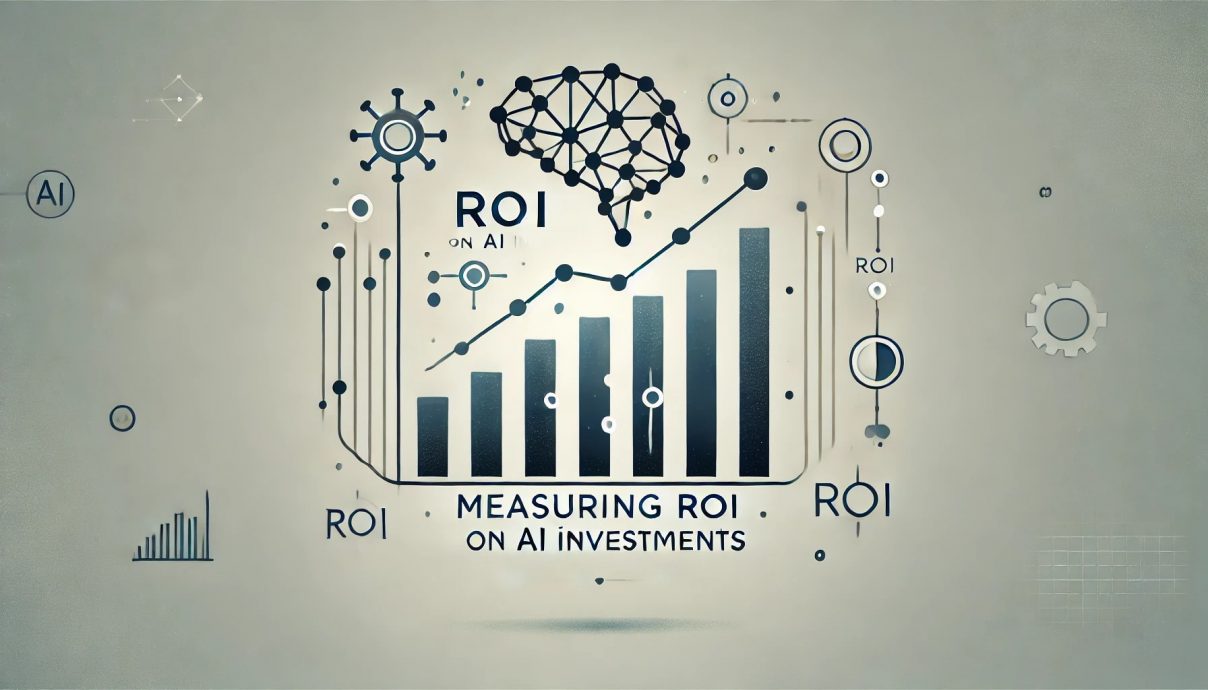
Unlocking Value: Measuring the ROI of Your AI Investments
Artificial Intelligence (AI) is no longer a futuristic concept; it’s a present-day reality transforming businesses across every sector. From automating repetitive tasks to providing hyper-personalized customer experiences, AI promises significant advantages. But amidst the hype and excitement, a critical question looms large for every business leader: How do we measure the actual return on investment (ROI) of our AI initiatives?
Investing in AI can be a substantial commitment, involving not just technology costs but also data preparation, talent acquisition, and organizational change. Without a clear understanding of the ROI, AI investments can feel like a leap of faith rather than a strategic business decision.
This comprehensive guide will break down the complexities of measuring AI ROI into easy-to-understand steps, helping you quantify the real value AI brings to your organization.
Why Measuring AI ROI is Absolutely Essential
Before diving into the ‘how,’ let’s understand the ‘why.’ Measuring AI ROI isn’t just about crunching numbers; it’s about strategic clarity and continuous improvement.
- Justify Investments & Secure Future Budgets: Demonstrating tangible returns proves the value of your AI projects, making it easier to gain approval for further investments and scale successful initiatives.
- Identify What Works (and What Doesn’t): ROI measurement helps you understand which AI applications are delivering real benefits and which might need re-evaluation or even discontinuation. It’s about learning from your successes and failures.
- Optimize AI Strategy: By tracking performance, you can refine your AI strategy, focusing resources on areas with the highest potential for impact and aligning AI efforts with core business objectives.
- Boost Accountability & Transparency: Clear metrics hold teams accountable for results and provide transparency to stakeholders about the progress and impact of AI projects.
- Gain a Competitive Edge: Organizations that effectively measure and act on AI ROI are better positioned to outmaneuver competitors by consistently optimizing their AI-driven processes and offerings.
The Unique Challenges of Measuring AI ROI
Unlike traditional IT projects where costs and benefits might be more straightforward, AI investments present several unique measurement challenges:
- Intangible Benefits: Many AI benefits, like improved customer satisfaction, faster decision-making, or enhanced innovation, are harder to quantify directly in monetary terms.
- Longer Time Horizons: AI models often require significant data, training, and fine-tuning before they deliver optimal results. ROI might not be immediately apparent and can take months or even years to materialize fully.
- Interdependence with Existing Systems: AI rarely operates in a vacuum. Its impact is often intertwined with existing business processes, making it difficult to isolate the exact contribution of AI alone.
- Data Quality & Availability: The success of AI heavily relies on high-quality, relevant data. Poor data can lead to inaccurate models, making it hard to achieve or measure desired outcomes.
- Evolving Technology: AI is a rapidly advancing field. What’s cutting-edge today might be commonplace tomorrow, requiring continuous updates and adjustments to models and strategies.
Despite these challenges, a structured approach can help you navigate the complexities and gain meaningful insights.
Setting the Stage: Pre-Investment Planning is Key
You can’t measure what you haven’t defined. The most crucial step in measuring AI ROI happens before you even launch an AI project.
1. Define Clear Business Objectives & Use Cases
Before investing a single dollar, ask: What specific business problem are we trying to solve with AI? Avoid vague goals like "implementing AI." Instead, focus on tangible outcomes.
Examples of Clear Objectives:
- Reduce customer service call handling time by 20%.
- Increase sales conversion rates on our e-commerce platform by 5%.
- Decrease fraud detection time by 50% and reduce financial losses from fraud by 15%.
- Optimize supply chain logistics to reduce delivery costs by 10%.
- Automate invoice processing to reduce manual errors by 80%.
2. Identify Key Performance Indicators (KPIs)
Once objectives are clear, define the specific, measurable KPIs that will indicate success. These are the metrics you will track to see if your AI solution is working.
Examples of KPIs Linked to Objectives:
| Business Objective | Key Performance Indicators (KPIs) |
|---|---|
| Reduce customer service call handling time | Average Handle Time (AHT), First Call Resolution (FCR), Customer Satisfaction (CSAT) Scores |
| Increase e-commerce sales conversion rates | Conversion Rate, Average Order Value (AOV), Customer Lifetime Value (CLTV) |
| Decrease fraud detection time & losses | Time to Detect Fraud, Amount of Fraudulent Transactions, False Positive Rate |
| Optimize supply chain logistics | Delivery Costs per Unit, On-Time Delivery Rate, Inventory Turnover Rate |
| Automate invoice processing | Manual Error Rate, Processing Time per Invoice, Labor Hours Saved |
3. Establish Baselines
Before implementing AI, you need to know where you’re starting from. Collect data on your chosen KPIs before the AI solution goes live. This baseline data will be your benchmark for comparison. Without a baseline, you can’t accurately attribute changes to your AI investment.
Key Categories for Measuring AI ROI
AI investments can yield returns in several distinct ways. Understanding these categories helps you identify all potential benefits, both direct and indirect.
1. Direct Financial Benefits (Monetary Gains)
These are the most straightforward and often the primary focus of ROI calculations.
- Cost Savings:
- Labor Cost Reduction: Automating repetitive tasks (e.g., data entry, customer service inquiries via chatbots) can reduce the need for manual labor or free up employees for higher-value work.
- Operational Efficiency: Reducing errors, optimizing resource allocation, or minimizing waste (e.g., predictive maintenance reducing equipment downtime).
- Reduced Overheads: Lowering energy consumption, optimizing inventory levels, or reducing physical infrastructure needs.
- Fraud Prevention: AI’s ability to detect anomalous patterns can significantly reduce financial losses due to fraud.
- Revenue Growth:
- Increased Sales: AI-powered personalization, predictive analytics for sales leads, or optimized pricing strategies can boost sales volumes and values.
- New Product/Service Development: AI can uncover market gaps or enable the creation of entirely new, data-driven products and services.
- Customer Retention: AI-driven insights into customer churn can help businesses proactively retain valuable customers, leading to higher lifetime value.
- Upselling/Cross-selling: AI recommendations can identify opportunities to sell more to existing customers.
2. Operational Efficiency & Productivity
While not always directly financial, these benefits often lead to cost savings or increased capacity.
- Faster Decision-Making: AI provides real-time insights, enabling quicker and more informed strategic and operational decisions.
- Process Automation: Streamlining workflows, eliminating manual steps, and reducing processing times.
- Improved Accuracy: AI can significantly reduce human error in data analysis, forecasting, and operational tasks.
- Resource Optimization: Better allocation of human capital, equipment, or inventory based on AI predictions.
- Scalability: Automated processes allow businesses to handle larger volumes of work without proportionally increasing resources.
3. Enhanced Customer Experience & Satisfaction
Happy customers are loyal customers, which indirectly impacts revenue and brand reputation.
- Personalization: Tailoring experiences, recommendations, and communications to individual customer preferences (e.g., Netflix, Amazon).
- Faster Response Times: AI-powered chatbots and virtual assistants can provide instant support, resolving queries quickly.
- Improved Product/Service Quality: AI can analyze feedback to identify areas for product improvement or service enhancement.
- Reduced Customer Churn: Predicting customer dissatisfaction and intervening proactively.
4. Risk Mitigation & Compliance
AI can help businesses identify and avoid potential pitfalls.
- Fraud Detection: As mentioned, AI excels at identifying unusual patterns indicative of fraudulent activity.
- Cybersecurity: AI can detect and respond to threats faster than traditional methods, protecting valuable data.
- Compliance & Regulatory Adherence: AI can monitor transactions and activities to ensure adherence to complex regulations, reducing the risk of fines and legal issues.
- Predictive Maintenance: Anticipating equipment failures reduces costly downtime and prevents safety hazards.
5. Innovation & Strategic Advantage
These are often long-term, less tangible benefits, but crucial for sustainable growth.
- New Business Models: AI can enable entirely new ways of delivering value or operating.
- Market Insights: AI can analyze vast datasets to uncover emerging trends, competitive landscapes, and unmet customer needs.
- Competitive Differentiation: Being an early adopter and master of AI can set your business apart.
- Enhanced Employee Experience: Freeing employees from mundane tasks, allowing them to focus on more creative and strategic work, boosting morale and retention.
Practical Steps to Measure AI ROI
Now, let’s put it all together into a step-by-step process for measuring your AI investments.
Step 1: Define Specific KPIs for Each Project
As discussed in the "Setting the Stage" section, this is non-negotiable. For every AI initiative, clearly articulate what you will measure and why.
Example: AI-Powered Customer Service Chatbot
- Objective: Reduce inbound call volume by 25% and improve CSAT by 10%.
- Key KPIs:
- Number of calls deflected by chatbot.
- Average resolution time for chatbot interactions.
- Chatbot escalation rate (percentage of queries escalated to human agents).
- Customer Satisfaction (CSAT) scores for chatbot interactions (e.g., a simple thumbs up/down rating).
- Cost per interaction (chatbot vs. human agent).
Step 2: Collect Baseline Data
Before your AI goes live, gather data for all your chosen KPIs. This provides the "before" picture. Ensure your data collection methods are consistent and reliable.
Step 3: Implement the AI Solution
Deploy your AI system and integrate it into your business processes.
Step 4: Track & Monitor Performance Continuously
Regularly collect new data for your KPIs after the AI implementation. Set up dashboards and reporting tools to visualize progress.
- Frequency: Daily, weekly, or monthly, depending on the KPI and the business cycle.
- Tools: Business intelligence (BI) tools, custom dashboards, AI platform analytics.
Step 5: Compare Performance Against Baselines
This is where the magic happens. Compare your post-AI KPI data with your pre-AI baseline data.
Example: Chatbot Data
- Baseline (Pre-AI): 10,000 inbound calls/day, AHT = 5 minutes, CSAT = 75%.
- After 3 Months (Post-AI): 7,500 inbound calls/day (25% reduction!), AHT for remaining calls = 4.5 minutes, CSAT = 82%.
- Chatbot Specific: 3,000 chatbot interactions/day, 80% resolution rate, 20% escalation rate.
Step 6: Attribute Results & Quantify Value
This is often the trickiest part. While correlation is easy to see, proving causation can be complex.
- Direct Attribution: If an AI system directly automates a task, the cost savings are relatively easy to attribute (e.g., labor hours saved, reduced error rates).
- Indirect Attribution: For benefits like increased customer satisfaction or faster decision-making, you might need to build a model that estimates their financial impact (e.g., how much does a 1% increase in CSAT translate to in customer retention and revenue?).
- Control Groups/A/B Testing: Where possible, run experiments. For instance, show AI-powered recommendations to one group of customers (A) and traditional recommendations to another (B) to see which performs better. This helps isolate the AI’s impact.
- Cost-Benefit Analysis:
- Total Costs: Sum up all AI-related expenses:
- Software licenses, cloud computing (e.g., AWS, Azure, GCP).
- Hardware (if on-premise).
- Data acquisition and preparation.
- Talent (data scientists, engineers, project managers).
- Training and change management.
- Maintenance and ongoing optimization.
- Total Benefits: Quantify the monetary value of all your measured improvements (cost savings, revenue increases, estimated value of intangible benefits).
- ROI Formula:
ROI = (Total Benefits - Total Costs) / Total Costs * 100%
- Total Costs: Sum up all AI-related expenses:
Step 7: Communicate & Iterate
- Report Findings: Clearly present your ROI analysis to stakeholders. Highlight successes, explain challenges, and share lessons learned.
- Adjust & Optimize: Use the insights gained to fine-tune your AI models, improve processes, or even pivot your strategy. AI is not a one-time deployment; it’s an ongoing journey of refinement.
Tools and Techniques for Better Measurement
- Business Intelligence (BI) Dashboards: Visualize KPIs and track performance over time (e.g., Tableau, Power BI, Looker).
- A/B Testing & Control Groups: Experimentation is crucial for isolating AI’s impact.
- Attribution Modeling: For complex scenarios, statistical models can help attribute specific outcomes to AI interventions.
- Customer Surveys & Feedback: Directly measure satisfaction, ease of use, and perceived value.
- Financial Modeling: Build models to estimate the monetary value of operational efficiencies or customer experience improvements.
Common Pitfalls to Avoid
- Ignoring Intangible Benefits: While harder to quantify, they often represent significant long-term value. Don’t leave them out of your narrative.
- Focusing Only on Short-Term ROI: AI often has a longer payback period. Be patient and plan for long-term measurement.
- Poor Data Quality: "Garbage in, garbage out." AI models built on poor data will yield poor results, making ROI impossible to achieve or measure.
- Lack of Clear Objectives: Without specific goals, you’ll never know if your AI investment was successful.
- Underestimating Implementation Costs: Don’t just budget for software. Account for data preparation, integration, talent, and change management.
- Lack of Organizational Alignment: If business units aren’t on board, AI adoption will suffer, impacting potential ROI.
Conclusion: AI ROI – A Journey, Not a Destination
Measuring the ROI of AI investments is undoubtedly complex, requiring a blend of financial acumen, data science expertise, and strategic vision. However, it is an indispensable practice for any organization serious about leveraging AI for sustainable growth.
By defining clear objectives, establishing baselines, rigorously tracking KPIs, and understanding both tangible and intangible benefits, you can move beyond the hype and truly unlock the transformative power of AI. Remember, AI is not a magic bullet; it’s a powerful tool that, when strategically applied and diligently measured, can deliver significant, quantifiable value to your business.
Embrace the challenge, commit to continuous measurement, and watch your AI investments turn into undeniable success stories.



Post Comment